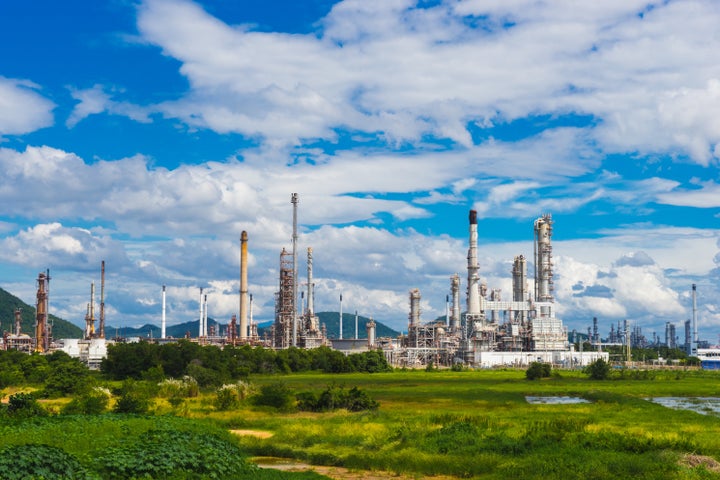
Attention: this is a fashion emergency. Your favourite dress, a delightful and familiar old friend that you may wear over and over again, could be doing huge damage to the world around you because of the way it was made and every time you now wash it.
Manmade materials can be extremely bad news for the environment. Polyester, for instance, one of the most popular textiles for making light, comfortable dresses (and many other items of clothing), has both plastic and pollutive processes woven into various stages of its life cycle. And it’s not the only material to watch.
So if you’re not wearing cotton or linen today - the best fabric choices if you’re looking for plastic-free fashion - we’ve pulled together a timeline of your garment’s life, what it could be doing to the planet in its average life span and what you can do to break out of the cycle.
The manufacturing stage
Derived from petroleum, polyester’s manufacturing process requires high levels of power in order to melt the oil. This is then squeezed into filaments and drawn into fibres, which are woven together to make the fabric. The emissions from the process, in turn, contribute to climate change.
Which means your pretty shift dress could be made from a by-product of crude oil.
It’s a similar story for acrylic fibre, a material used to make fake fur and many high-street jumpers. It also has a close relationship with plastic pollution, being made from a chemically produced substance called acrylonite, which is used in the production of plastics.
So before your clothes even make it to the shops, their manufacture may already have made a huge impact on the planet.

The shopping stage
When you look at the price tag of an item of clothing, it’s worth also taking a look at the label that lists the materials from which it is made. If that is not natural fibres, you might find that polyester, or another synthetic artificial fibre made from plastic, has been blended in there somewhere.
Polyester’s versatility is one of the key reasons why its so popular with fashion brands, and its presence in your clothes can be very easy to miss. Annoyingly, it can sometimes be hard to track down the different textiles that have been added to a blended fabric.
And it doesn’t stop with your favourite dress. You can find polyester (and, by extension, a hell of a load of plastic microfibres) across your wardrobe. From your gym gear to your winter fleeces, even your underwear. The production of polyester is also expected to triple by 2025, due to a lack of natural resources to grow cotton, and the need for a new go-to textile.

The laundry stage
Once you’ve worn your favourite (or dress, or leggings, or skirt) a few times, you throw it in the washing machine to freshen it up. Problem is, every time you do, you may be contributing to the world’s plastic pollution problem. While you can find plastic in lots of your favourite things – be it your cup of tea or the wrapper of your chocolate bar of choice – the problem unfortunately goes much wider.
Just as plastic is a part of their manufacturing process, polyester, fleece and acrylic also shed plastic microfibres when washed, leading to contamination of our water supply.
One million tons of microfibres are released into wastewater each year from laundry washing, according to Orb Media. The amount that sheds also increases as the clothing gets older, as it wears down more rapidly. Once this wastewater reaches our oceans, these plastic microfibres can absorb chemicals - these then either enter our drinking water or are ingested by fish and end up in our food chain. Scary stuff.
According to Julian Kirby, plastic pollution campaigner at Friends of the Earth, our plastic pollution crisis makes redesigning clothes to prevent further plastic “leaking in to the environment” vital.
“If companies can redesign their clothes using materials with no risk of shedding plastic particles when worn and washed, then perhaps we could consider their products environmentally sound at least when it comes to plastic pollution. If not, we should really be asking whether these products need to make a trip to the laundry bin,” he tells HuffPost UK.

Breaking the cycle
Various start-ups are also working on developing new materials that do not need plastic for any stage of its life. Spider silk – which is literally made from spider webs – is being tipped as a replacement for some synthetic fabrics due to its durability.
But for now, if you own a dress that is made from these materials, make sure you only buy and wash them when absolutely necessary, thus reducing the rate of manufacture and of plastic microfibres being released when they are washed. And, when you can, go for dresses (or other clothing) made from non-synthetic materials, such as cotton, silk or linen.
Jane Patton, Managing Director of Plastic Pollution Coalition, feels that fast fashion and the industry’s failure to find eco-friendly materials is at the centre of the problem and therefore should be at the centre of its solution.
At the Lush Summit in February this year, she said :“We accumulate these clothes because it is pushed on us. The solution? Choose cotton, wash polyesters less, look at ways to use other solutions if they work, but also, ask for better. Go back to the retailers.”
